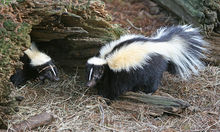With 12 cases of equine rabies already confirmed in 2013, horse owners should be vigilant about vaccinating their horses against this fatal disease.Those equine cases are among the hundreds of cases discovered this year in other species, including: bats, cats, dogs, cows, foxes, raccoons and skunks.1

Skunks and other wild life - Carriers of Rabies
Besides the cases in horses, in the past several years, there have been thousands of incidents of animals with confirmed rabies, 92 percent of which were in wildlife.
© 2013 by Tom Friedel
“In 2011, which is the last year for which we have complete data, there were 44 confirmed cases of rabies in horses.2 But what really should be a concern for horse owners is the number of cases in wildlife as most horses are kept in areas near wildlife habitats,” says Megan Green, DVM, equine specialist, Merial’s Large Animal Veterinary Services.
“I’m sure every barn owner has seen skunks, foxes, raccoons and the occasional bat in and around their barns.”
Besides the cases in horses, in the past several years, there have been thousands of incidents of animals with confirmed rabies, 92 percent of which were in wildlife2:
- 2009 – 6,6943
- 2010 – 6,1552
- 2011 – 6,0372
Unfortunately, the fate of horses that contract rabies is dismal, as rabies is always fatal. Clinical signs include, but are not limited to, going off feed, depression, excessive salivation, difficulty swallowing, lack of coordination, aggressive behavior, hyperexcitability, colic, convulsions or paralysis.4
These signs are similar to other diseases affecting the horse’s nervous system, but in the case of rabies, become so severe, the horse is euthanized or dies within days.
Because there is no way to diagnose rabies in live animals,5 horse owners and the treating veterinarians who suspect rabies face the gut-wrenching task of sending the horse’s brain to a diagnostic laboratory where it is examined for the presence of lesions which are characteristic with rabies.5
“Horse owners have significant emotional and financial resources invested in their horses over long periods of time and consider their horses to be family,” says Dr. Green. “Their vision for the animal’s end of life tends toward retired days grazing in green pastures – not convulsions, paralysis and a painful death.”
Rabies brings significant heartache to horse owners and can be avoided with just one simple step – vaccination. “The cost associated with a rabies vaccination is minimal – but the peace of mind it buys is priceless,” says Dr. Green.
In the case of rabies, horse owners can rely on the IMRAB® rabies vaccine from Merial to help protect their horses.
Staying Informed with Oubreak Alert
While the only way to help prevent devastating equine diseases such as rabies is to vaccinate, staying informed about the threat of disease can also be helpful. Merial’s Outbreak Alert program, launched in June 2011, is a tool horse owners can use to evaluate risk, especially when traveling.
The program features a website with maps indicating the presence of confirmed cases in all species, including the carriers of rabies, West Nile Virus, Eastern Equine Encephalitis, Western Equine Encephalitis, Influenza, Potomac Horse Fever and Equine Herpes Virus. Free, printable information about each of the diseases, their clinical signs and treatments, is also available on the site.
For more information about Merial’s vaccines
For more information about or to sign up for Outbreak Alert
About Merial
Merial is a world-leading, innovation-driven animal health company, providing a comprehensive range of products to enhance the health, well-being and performance of a wide range of animals. Merial employs approximately 6,000 people and operates in more than 150 countries worldwide. Its 2012 sales were $2.8 billion.
Merial is a Sanofi company.
®IMRAB is a registered trademark of Merial. ©2013 Merial Limited, Duluth, GA. All rights reserved. EQUIBGN1306 (04/13)
1Data on file at Merial.
2Blanton JD, Dyer J, McBrayer J, Rupprecht CE. Rabies surveillance in the United States in 2011. JAVMA 2012;241(6):712-722.
3Blanton JD, Palmer D, Dyer J, Rupprecht CE. Rabies surveillance in the United States in 2010. JAVMA 2011;239(6):773-783.
4Rabies Surveillance Data in the United States. Available at: www.cdc.gov/rabies/location/usa/surveillance/. Accessed April 25, 2013.
5Rabies in Horses. Michigan State University. College of Veterinary Medicine. Available at: www.cvm.msu.edu/alumni-friends/information-for-animal-owners/rabies-in-horses/. Accessed April 25, 2013.
